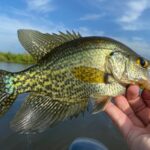Nothing says ‘hello summer‘ like a bucket full of panfish. But one panfish, in particular, the mighty bluegill, reigns above all…
Below we will talk about these tiny, but mighty fish, and discuss whether you can eat them!
Table of Contents
So, Are Bluegill Good To Eat?
Bluegill is one of the tastiest, knee-slappin’, scrumptious, and fun fish to catch and eat!
No, not in the same way that you sit down and eat a $40 swordfish steak at a fancy restaurant…
And not the same way you eat a fried grouper sandwich with fancy drinks on a crystal clear beach…
Bluegill are for the everyday, blue-collar, and hard-working anglers! A mess of fried bluegill with friends or family is hard to beat.
Pair them with hush puppies, grits, baked beans, and cole slaw…heck maybe a few cold beers too!
Bluegill are not known for the delicate flavors and undertones for the seafood connoisseur, but they are a tasty and delicious fish that are equally as fun to catch as they are to eat.
Can You Eat Bluegill?
Yes, you can eat Bluegill. They are an abundant fish species found all over North America and are considered very good table quality by anglers.
The meat is firm, mild-flavored, and best prepared fried or cooked whole.
Does Bluegill Taste Good?
Although they are small (usually 10 inches or less), Bluegill is considered a top choice among the sunfish family for cooking and taste quality.
The meat is mild, firm, and an excellent choice both as a formal dinner or camp meal. It does not have a fishy taste.
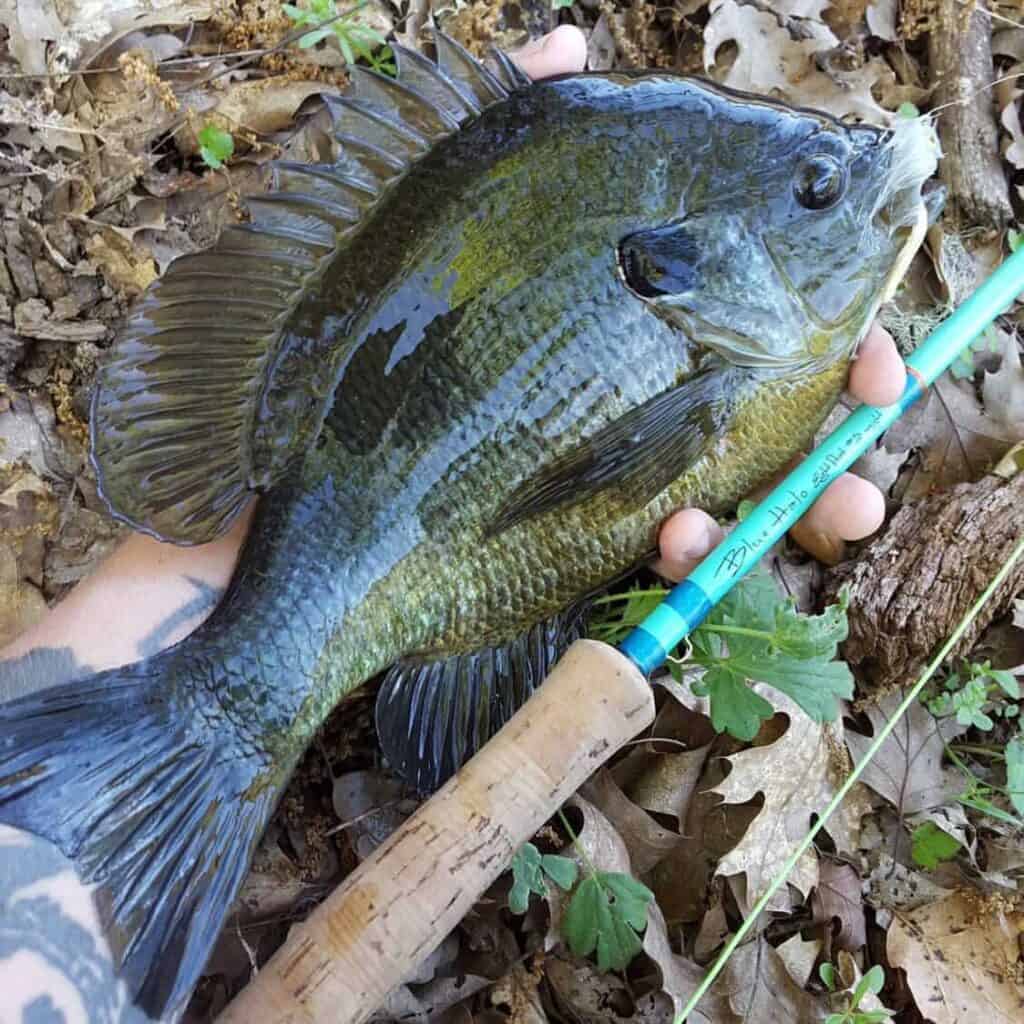
Are Bluegill Poisonous?
No, Bluegill are not poisonous. They are consumed by millions of anglers every year and remain one of the most popular Sportfish in North America.
The spines are not poisonous, and they do not have sharp teeth.
Can You Eat Bluegill Skin?
Yes, you can eat Bluegill Skin. First, you’ll need to remove the scales. To do this, use a dull knife or a fish de-scaler to rub back and forth against the scales.
You can also use a light wire brush. After the scales are removed, thoroughly rinse the fish with clean water before cooking.
Due to their small size Bluegill are often eaten whole, with only the head, organs and scales removed.
The skin of Bluegill is an excellent source of vitamins and minerals and turns very crispy when fried, delicious!
Can You Eat Bluegill Eggs?
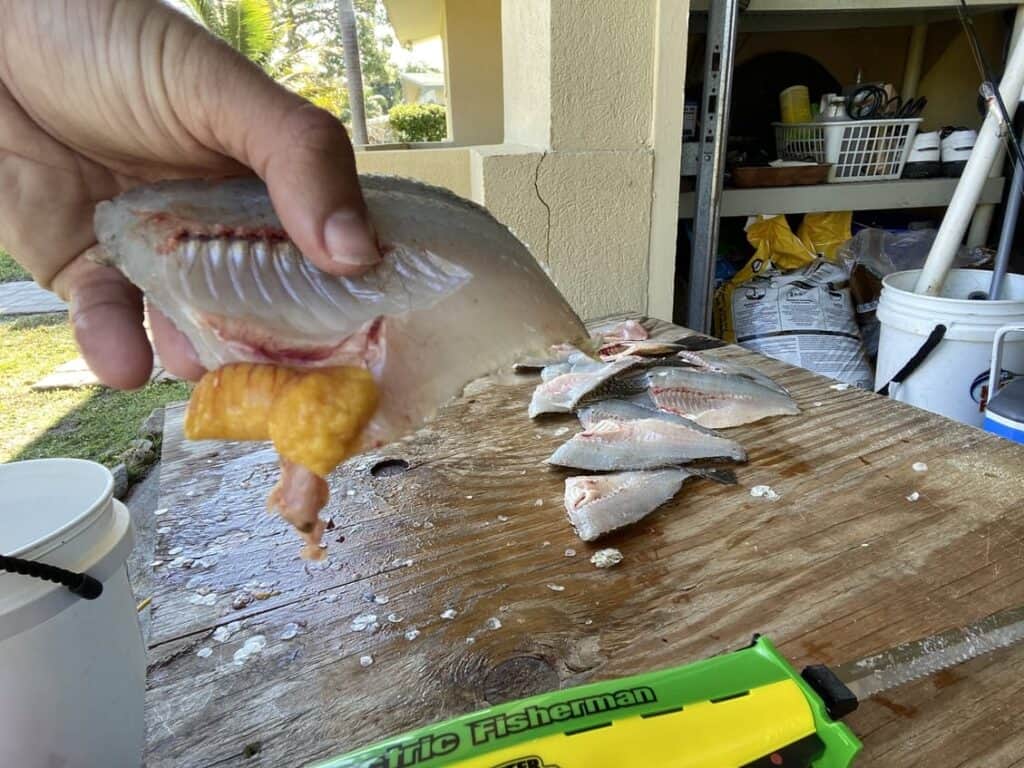
Yes, Bluegill eggs or “roe” can be eaten and are sometimes considered a delicacy. To eat the eggs, carefully remove the egg sac when cleaning your fish.
Females will often have eggs during the summer spawning season. Simply flour and season the egg sac, and quickly fry. They are a flavorful addition to your fillets and very nutritious!
Can You Eat Bluegill Raw?
Eating Bluegill and other freshwater fish raw is a controversial and debatable subject.
Many sources will tell you that eating Bluegill raw puts you at risk of contracting microscopic worms or other parasites that may be present in the meat before cooking.
Others may say that consuming raw Bluegill is uncommon, yet poses no additional health risks.
In any case, by far the most common method to eat Bluegill is cooked, not raw. Always consult your doctor and health officials if you have questions about consuming fish meat.
Are Bluegill Healthy To Eat?
Not only are Bluegill delicious, but these tasty little fish are also very nutritious! Bluegill are a low-calorie and low-carbohydrate meal option and an excellent choice for maintaining both your heart health and a healthy weight.
It’s hard to believe that just three ounces of bluegill provides 21 grams of protein! That’s almost half of your recommended daily amount of protein!
See My Amazon Picks: Best Panfish Lures & TackleThey are also very low in saturated fats, containing only 1 g per serving. An excellent lean protein source to add to your diet.
Lastly, Bluegill are full of great micronutrients like iron and Vitamin B12, which aid in healthy red blood cell production. Bluegill also generally has low concentrations of mercury.
Always check your water source and know where your fish comes from, prior to eating any. Some bodies of water are known to be higher in chemicals than others.
| Reasons Why Bluegill is Great to Eat |
|---|
| Low in Mercury: Bluegill is a small, freshwater fish that is low in mercury, making it a safe and healthy option for consumption. |
| High in Protein: Bluegill is a rich source of protein, with a 3-ounce serving containing about 20 grams of protein. |
| Low in Fat: Bluegill is a lean fish, with only about 2 grams of fat per 3-ounce serving. |
| Rich in Omega-3 Fatty Acids: Bluegill is a good source of omega-3 fatty acids, which are essential for maintaining heart health, brain function, and reducing inflammation. |
| Versatile: Bluegill can be cooked in a variety of ways, including frying, grilling, baking, or sautéing. |
| Delicious: Bluegill has a mild, sweet flavor that is often compared to other popular freshwater fish like trout and perch. |
Can You Eat Bluegill From A Pond?
Generally speaking, eating bluegill from a pond is fine, as long as the pond is in a natural setting.
Avoid eating Bluegill from residential ponds, golf course ponds, retention ponds, and other small bodies of water that likely contain pollutants from pesticides and fertilizer.
What’s Better To Eat, Crappie Or Bluegill?
The Fishing Magazines and Outdoor Cooking Shows will have you believe that Crappie is superior to Bluegill…. and I would have to agree!
Crappie is a whiter and more mild fillet, enjoyed by people all over North America.
But, to answer what fish tastes better, is truly subjective to personal taste and preferred cooking methods.
From my experience, if you put a whole mess of fried Bluegill and Crappie in front of hungry anglers, you will hear no complaints and many probably couldn’t tell you the difference between the two!
How To Clean & Fillet Bluegill
There are many ways to clean and fillet bluegill and in most cases, all you need is a clean sharp fillet knife.
Many anglers prefer to use an electric fillet knife when cleaning Bluegill and other panfish. This can make the process very quick and efficient, especially when cleaning a large quantity of fish.
This video by Catfish and Carp YouTube Channel shows how to Catch, Clean and Cook Bluegill:
How To Prepare Bluegill To Eat
Bluegill can be prepared to eat a few different ways, and no one way is better than the other. However, there are a few things you can do to keep your catch fresh and ready for a delicious meal:
- Put your Bluegill catch on Ice, on a stringer in the water, or in a live-well immediately after catching. This will preserve the firmness of the meat and reduce the risk of contamination.
- Keep the fish out of direct sunlight.
- Prepare your fish cleaning station or area. This should be a clean surface free from dirt. Have a hose or clean water nearby for rinsing and sanitizing.
- Use the correct tools. In most cases, all you need is a clean and sharp fillet knife. Optional tools include a glove, fish de-scaler or fish pliers.
- After cleaning your fish, whether they are fillets or whole fish (gutted) immediately place them in a dry cool space. This can be back on ice or in the refrigerator until they are ready for freezing.
- Fresh Bluegill can remain in a refrigerator up to 24 hours before cooking. Otherwise, properly bag your fish in freezer storage bags and freeze until ready to use.
How To Cook Bluegill
Bluegill is a firm and mild-flavored fish so it can be prepared in a number of different ways. My personal favorite and probably the most common way is pan-fried (Afterall, that is why they are called Panfish!).
Plan on 4-6 bluegill fillets per person as a meal. Grits, baked beans, salad, and potatoes all make excellent sides with cooked Bluegill. There is no better time than summer to catch big Bluegill!
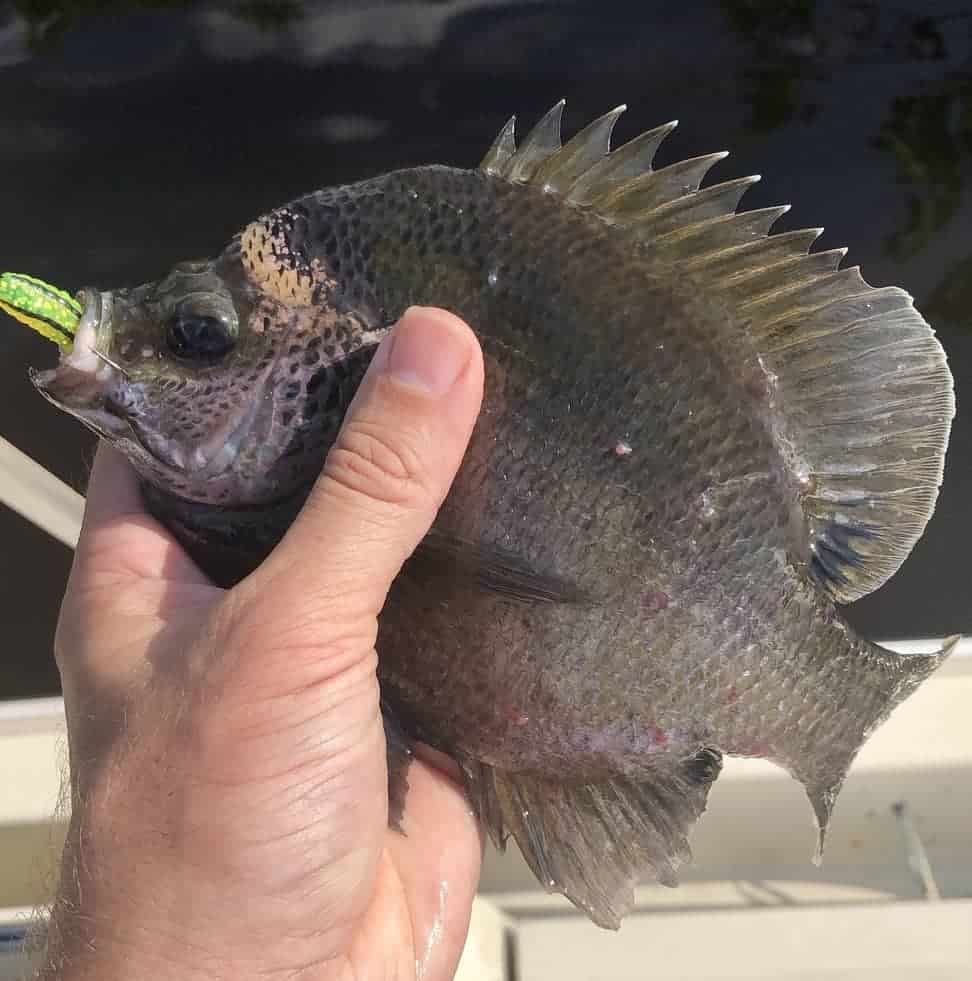
Pan Fried Bluegill Recipe
INGREDIENTS
- 12-15 fillets of fresh bluegill (skin removed)
- 2 cups milk
- 1 egg slightly beaten
- 1 cup cornmeal or fish fry mix
- 1- 2 tablespoons Old Bay seasoning
- salt and pepper to taste
- 8 cups peanut oil
INSTRUCTIONS
- Mix milk and egg in a medium bowl. Whisk until fluffy. Add fish fillets and let soak for 5-10 minutes.
- In a medium bowl add cornmeal or fish seasoning, Old Bay seasoning, and salt and pepper.
- Heat peanut oil in Cast Iron Skillet or non-stick pan over medium heat. Once ready, quickly take fish fillets and coat in cornmeal or fish fry mixture. Be sure to coat both sides of the fillets, and shake off excess.
- Place fillet in hot oil for frying. Depending on the size of the fish, it takes 1-2 minutes per side, until cooked. Carefully remove and place on a plate with a paper towel.
- Garnish with Lemon (optional) and dip in ketchup, tartar sauce or eat plain! YUM!
Whole Fried Bluegill Recipe
INGREDIENTS
- 8-12 whole bluegill (head, scales and guts removed)
- 4 cups milk
- 2 egg slightly beaten
- 4 cup cornmeal or fish fry mix
- 1- 2 tablespoons Old Bay seasoning
- salt and pepper to taste
- 8 cups peanut oil
INSTRUCTIONS
- Mix milk and egg in a medium bowl. Whisk until fluffy. Add fish fillets and let soak for 5-10 minutes.
- In a large bowl add cornmeal or fish seasoning, Old Bay seasoning, and salt and pepper.
- Heat peanut oil in deep fryer or dutch oven over medium heat. Once ready, quickly take whole fish and generously coat in cornmeal or fish fry mixture and shake off excess.
- Place whole fish in hot oil for frying. Depending on size of fish, it takes 3-4 minutes until cooked. Carefully remove and place on a plate with a paper towel.
- Remember, these are whole fish so be careful eating around bones. Meat can be easily peeled away with a fork and fins are crispy and crunchy treats!*
Baked Bluegill Recipe
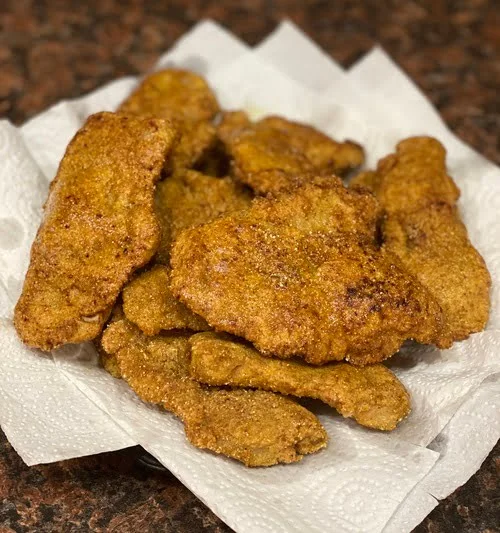
INGREDIENTS
- 6-8 Bluegill fillets (skin removed)
- 2 cups milk
- 1 egg
- 1/3rd cup all-purpose flour
- 2/3rd cups corn flakes or panko bread crumbs
- 1 tbsp grated parmesan cheese
- 2 teaspoon cayenne pepper
- 1 teaspoon black pepper
- salt to taste
INSTRUCTIONS
- Preheat oven to 425 degrees Fahrenheit. Prepare a shallow baking tray with non-stick cooking spray.
- In a medium bowl, combine flour, salt, and black pepper.
- Mix milk and eggs in a medium bowl. Whisk until fluffy and add fish fillets to soak for 5-10 minutes.
- In a separate medium bowl, mix the corn flakes or panko bread crumbs, cayenne pepper, and parmesan cheese.
- After the fillets have soaked in the milk and egg wash, dip them into the flour, then into the cornflake and cheese mixture. Pat the ingredients generously onto the fillets and carefully place them onto a baking sheet.
- Cook for 6-10 minutes until cornflakes and breadcrumbs are crispy brown. Fillets should be fork tender and ready to eat.
ABOUT BLUEGILL
Bluegill (Lepomis macrochirus) is a freshwater fish species that is a member of the sunfish family. They are the most common and widely distributed of all the sunfish species.
Bluegill are often referred to as ‘sunfish’ by anglers. Other nicknames include ‘bream’, ‘coppernose’ or ‘sunny’s’.
Appearance– Bluegill have the deep-bodied look of panfish, a small mouth, long dorsal fin, and a slightly forked tail.
Their distinct feature is a dark ear covering and a blotch at the dorsal fin’s back bottom edge.
They are found throughout North America from Mexico to Canada and have even been introduced into other parts of the world.
Habitat– Bluegill can be found in a wide variety of habitats, ranging from roadside ditches to deep natural lakes.
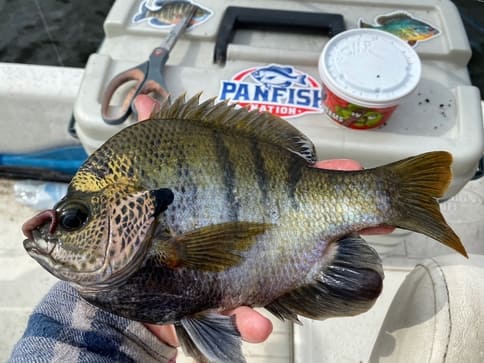
They prefer the still waters of freshwater lakes, ponds, lagoons, and quiet creeks but can also be found in canals, reservoirs, and rivers.
They seek out cover in aquatic vegetation such as hydrilla, lilypads, and cat-tails or find refuge in structures such as dock pilings, brush piles, and submerged logs.
Behavior– Bluegill feed primarily on insects and their larvae, but they will readily take worms, small minnows and freshwater crustaceans.
Throughout early spring and summer, Bluegill spawn and create “beds” in shallow sandy areas where male bluegill defend the nest from predators.
They are prolific breeders and it is not uncommon for anglers to catch 50-100 fish per day.
Fishing Tips- Grass shrimp, live worms, and crickets are the best live baits to use when targeting bluegill. For artificial, the best lures for Bluegill are beetle spins, surface poppers, or ultra-light crankbaits.
Bluegill bite best during early morning and late afternoons but can be caught all day long in the warmer months of spring and summer.
Focus on vegetated areas, usually in 8 feet of water or less. Where there is one bluegill, there is usually more!
Conclusion
The reason that Bluegill is one of the most popular sportfish in North America is because they are plentiful, they have very generous bag limits, they are fun and easy to catch- and they are delicious!
Next time you’re out on the lake, or fishing at your local pond, try catching a few Bluegill for the dinner table…I promise you won’t be disappointed!
If you haven’t guessed yet, I love fishing and everything about it!
To learn more about why I started Panfish Nation, visit the About page and follow along on Social Media:


Download a copy of my FREE Lure Color Selection Chart & Knot Guide!
Stay up to date with fishing reports, tackle reviews, industry news, and much more! We respect your privacy, unsubscribe at any time.
Additional Reading
- Crazy Facts About the World Record Crappie

- What Size Hooks for Smallmouth Bass? Quick Guide

- Large and in Charge-Mouth: 10 of the Best Bass Lures of All Time (And Where to Buy Them)

- Emperor of the Sun(fish): What You Need to Know About the World Record Bluegill
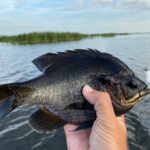
- The Seven Best Lures for Fall Bass Fishing
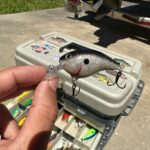
- Which Fishing Line is Best for Bass Fishing With A Spinning Reel?

- What Size Hooks for Panfish?
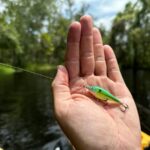
- Coppernose Bluegills: How They’re Different from Common Bluegill
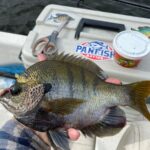
- Best Crappie Lakes In North Carolina
